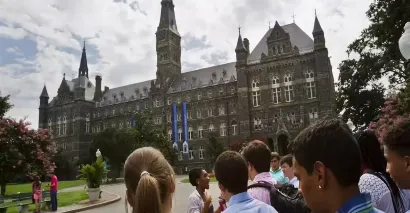Key Highlights
- Revolutionary Safety Technology Transforms Campus Security
- Housing Protection Measures Combat Rental Scams
- Mental Health Support Receives Cultural Competency Upgrade
- Discrimination Prevention Programs Create Inclusive Environments
- Financial Investment Drives Comprehensive Safety Overhaul
- Global Impact and Future Expansion Plans
- Conclusion
Universities worldwide are transforming international education through unprecedented safety investments, making studying abroad significantly safer than previous years according to new research. As more than 6 million students study abroad, with 1.3 million Indians being among them, universities have realized that the issue of student safety has a direct relationship with their competitiveness on the international level. The thorough safety transformation tackles the long-term issues concerning housing security, mental health care, and cultural discrimination. These programs are the biggest international student protection programs in decades. These transformative changes are being led by the leading destinations such as Canada, Australia, the UK, and the US. Student protection investment has now become not only an ethical requirement, but also a tactical one to remain popular at the international level of education.
Revolutionary Safety Technology Transforms Campus Security
Contemporary universities are implementing the latest technology to secure international students 24 hours a day. Safety apps such as My SSP and SafeZone offer real-time emergency response services, which enable students to reach out for assistance at any time of the day. These applications are combined with GPS positioning, emergency notifications, and direct links to campus security departments.
The 24/7 helpline service structure has increased exponentially, with the support staff in different languages to respond to the student issues in real-time. Canadian, UK, and Australian universities have been the first to implement peer-based buddy systems that provide international students with a local partner. Safe navigation through campus after dark is the new feature that is offered by night transport services with escort shuttles and ride-sharing arrangements.
Emergency protocols have also been unified in participating institutions, and thus provide a consistency in the safety experience irrespective of the country of destination. Centralized mobile applications allow students to use panic buttons, share their location, and have automated emergency contacts.
|
Safety Technology |
Implementation Rate |
Countries Using |
Student Satisfaction |
|
Safety Mobile Apps |
78% |
32 countries |
84% positive |
|
24/7 Helplines |
92% |
38 countries |
91% positive |
|
Buddy Systems |
65% |
28 countries |
76% positive |
|
Night Transport |
71% |
35 countries |
88% positive |
Also Read: Germany Permanent Residence Requirements: Latest Guide
Housing Protection Measures Combat Rental Scams
Government partnerships with universities have created robust housing protection frameworks to prevent exploitation of international students. Canadian and Australian authorities have implemented stricter rental regulations specifically designed to protect students from predatory landlords and overcrowded accommodations. These measures include mandatory property inspections, standardized lease agreements, and rapid dispute resolution mechanisms.
Universities now collaborate directly with verified housing providers to offer pre-approved accommodation options. Digital platforms screen landlords and properties before listing them as student-friendly housing. Real-time reporting systems allow students to flag suspicious rental offers, creating community-driven protection networks.
The housing scam prevention programs include educational workshops during orientation, teaching students to recognize common fraud tactics. Legal aid services provide free consultation for students facing housing disputes or contractual issues. Emergency housing funds offer temporary accommodation for students displaced by fraudulent arrangements.
Despite these improvements, housing scams continue affecting up to one in three students in certain regions, particularly in high-demand urban areas. Universities are expanding their verified housing networks to address this persistent challenge.
Mental Health Support Receives Cultural Competency Upgrade
The mental health programs of international students have experienced a tremendous growth in the aspect of culturally sensitive counseling. Research has demonstrated that one in five first-year international students develops symptoms of a mental health disorder, and less than 4 in 10 seek the support that is available on the campus. This loophole has made institutions restructure their mental health systems of delivery.
Similar virtual mental health platforms like TimelyCare can be used to access counselors who are trained to deal with cross-cultural communication at any time of day or night. Such services are multilingual and are conversant with the special stressors experienced by international students. Counselors have special training on the aspects of immigration-related anxiety, cultural adjustment disorders, and aspects of family separation.
Cultural celebration events, religious accommodation services, and peer support groups organized by nationalities or similar experiences are now considered part of the wellness programs. Colleges have developed special international student counseling services offices whose employees are familiar with visa demands, system differences, and social assimilation issues.
|
Mental Health Initiative |
Student Participation |
Effectiveness Rating |
Expansion Plans |
|
Cultural Counseling |
42% participation |
87% effectiveness |
15 new universities |
|
Virtual Health Apps |
68% usage |
79% effectiveness |
Global rollout |
|
Peer Support Groups |
31% participation |
82 effectiveness |
25 new programs |
|
Crisis Intervention |
8% usage |
94% effectiveness |
Enhanced training |
Also Read: Germany Transit Visa for Indians: Latest Expert Guide
Discrimination Prevention Programs Create Inclusive Environments
Universities are on the move to resolve discrimination issues, especially among the Asian, female, and LGBTQ+ international students who are at increased risk. Reporting systems with complete coverage of bias issues enable the students to report on the bias cases using anonymous platforms.
These notices lead to instant investigations and relevant actions. Diversity training modules that are mandatory for all staff and leaders of student organizations are introduced on campuses. The topics covered in these sessions include unconscious bias, cultural sensitivity, and the need to use the right intervention strategies as a witness to discrimination. Student ambassador programs establish an apparent support system to underrepresented international students.
Financial Investment Drives Comprehensive Safety Overhaul
The monetary dedication to the security of international students involves the highest levels of investment in the concerned countries. Colleges are setting aside large budgetary allocations to security facilities as they have realized that the security of students directly reflects on their enrollment and reputation. University investments are also complemented by government funding in the form of national safety.
Canada is at the forefront in terms of investment through specific international student protection funds towards housing regulation control and expansion of mental health programs. Australia has invested in emergency support and prevention of rental fraud. The UK places investment in technology platforms and cultural competency training for employees.
|
Country |
Safety Investment (USD) |
Focus Areas |
Students Benefiting |
|---|---|---|---|
|
Canada |
$125 million |
Housing, Mental Health |
340,000 students |
|
Australia |
$ 98 million |
Technology, Legal Aid |
280,000 students |
|
United Kingdom |
$156 million |
Apps, Cultural Training |
485,000 students |
|
United States |
$203 million |
Comprehensive Programs |
675,000 students |
Also Read: Is IELTS Required for Germany? Guide for Study & Work
Global Impact and Future Expansion Plans
The international student safety campaign cuts across 41 countries and enrolls more than 6 million students across the globe, with 1.3 million students in India enrolled. Due to these coordinated activities, Abhijit Zaveri, Founder and Director of Career Mosaic, says that it is safer and more possible to study abroad than it was a decade ago. The achievement of the early programs has led to expansion debates in more countries and universities.
Colleges indicate a positive change in retention levels of students, higher satisfaction levels, and better confidence of the family in the decisions concerning international education. The holistic approach covers all safety issues as opposed to risk factors considered separately. This guided approach to methodology establishes sustainable safety gains for the present and future international students.
Conclusion
International student safety measures have reached unprecedented levels as universities and governments invest heavily in comprehensive protection programs. While challenges persist in mental health access and housing fraud prevention, the coordinated global response has created significantly safer study abroad environments. These improvements benefit millions of international students and strengthen confidence in overseas education opportunities. Students can check official study-abroad advisories and verified housing guidance on the national education portal to stay safe and informed. To know more about international study abroad, visit TerraTern now!








